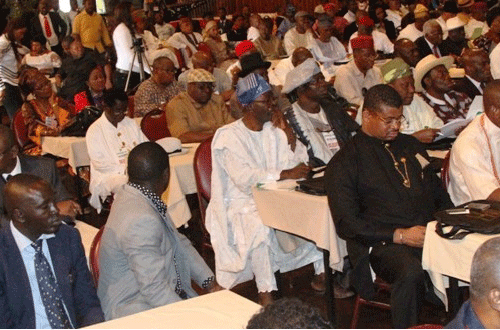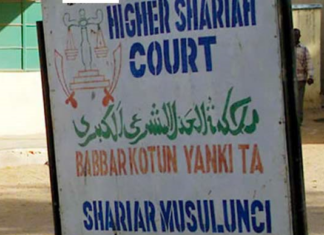Editor, Politics/Features, Emeka Alex Duru, takes a look at the controversies trailing the on-going national conference, raising concerns on the confab going the way of previous ones
Even before its inauguration on Monday, March 17, 2014, informed observers had predicted the procedural and logistics issues trailing the on-going national conference. At the resumption of the conference on March 24, after a one-week recess, for instance, there was the challenge of agreement on the actual number of delegates required to arrive at a decision on an issue.
Delegates
Though the delegates eventually settled for 70 per cent of the number required to arrive at agreement, it was not without some difficulties
Government, at inception, had prescribed consensus or three-quarters of the 492 delegates agreeing on an agenda before it would be passed. But by the close of last week, it had become apparent that members were clearly uncomfortable with the rule which they considered restrictive. The argument by those kicking against the directive was that in a country as Nigeria, with its multi-ethnic and religious tendencies, arriving at a consensus or 75 percent agreement by the members on an issue would remain a mirage.
Mike Ozekhome, a Senior Advocate of Nigeria (SAN), argued in this line, stressing that what was needed was a simple majority or, at most, two-thirds agreement by the members on an issue. Some other delegates made similar observation.
Before the latest development, many groups and individuals had complained about exemption from the list or the ability of some delegates to represent their constituencies. Critics had also accused the government of nursing a hidden agenda in convoking the confab.
All Progressives Congress (APC), the leading opposition political party in the land, had, for example, described the exercise as an agenda by President Goodluck Jonathan to oil his 2015 re-election machine, faulting particularly the timing of the gathering, which it said was intended to give Jonathan and his party, the Peoples Democratic Party (PDP), head-start over others in the build-up to next year’s general election.
Government’s directive on the conferees from discussing the indivisibility and indissolubility of Nigeria has also been seen as an attempt to sweep under the carpet the contentious issues that many had insisted needed to be discussed in arriving at equitable and acceptable federation.
Obviously aware of the regime of apprehension trailing the project, the presidency had insisted that there was no hidden agenda in it, stressing rather that the assignment is intended to define the future of the country.
The president had, for instance, recalled that, for many years, Nigerians had craved to talk on how the different components of the country could co-exist on a mutually-acceptable term.
The desire, he stated, is borne out of the realisation that the 1914 amalgamation of the Northern and Southern Protectorates to form Nigeria did not have the input of the people, hence the mutual distrust that has threatened the fabric of the nation’s unity.
Curiously, successive administrations had avoided open engagements on the issues involved, fearing that allowing discussions on such areas may lead to dismemberment of the country. It was against this backdrop that when this latest initiative was mooted by Jonathan on October 1, 2013, it was greeted with mixed feelings.
The president, however, went ahead to appoint Senator Femi Okunrounmu, a frontline Afenifere leader, as chairman of the Presidential Advisory Committee which advised the government on the modalities for the convocation of the conference.
The committee toured the country and collated views from Nigerians on modalities for the talks. Its production of report within stipulated time, however, did not dispel fears from Nigerians on government having an agenda.
This suspicion was further fuelled by calibre of delegates and manner of their appointment, which was by nomination and not by election as many had angled for.
The Okorounmu committee was, for instance, said to have recommended that the conference would have no ‘no-go-areas’. It also recommended that a majority of delegates would be elected directly on the principles of universal adult suffrage and that each senatorial zone would send four elected delegates, while the state governments would nominate one delegate each.
In addition, the Federal Capital Territory (FCT) was to nominate one delegate and the president to nominate delegates for key interest groups. But the nominated delegates are not to exceed one-third of the total number.
However, in its White Paper, the federal government nominated 20 delegates, while state governors and the FCT administration nominated 109 delegates, three from each state and one from the FCT.
Also, professional bodies, ethnic, religious and other organisations nominated members to represent their interests at the conference.
Other nominations included 37 elder statesmen, one per state and the FCT, made by the president.
Based on its configuration, there have been fears of the conference meeting the demands of the people. Some analysts have even argued that the conference, as it is presently constituted, may not be what Nigeria needs to get out of its socio-political problems.
Sylvester Ugoh, Governor of the defunct Central Bank of Biafra and former Minister of Science and Technology, for instance, told TheNiche that the conference may not really provide the solution to Nigeria’s problems, given that what is holding the country down is not its constitution but the skewed value system of those operating the constitution.
“I don’t think that the conference, as such, can solve our basic problems. This is because our basic problem, really, is not the constitution but the people who operate the constitution,” he observed.
Tunji Abayomi, lawyer and human rights activist, is also not convinced on the essence of the conference. He is particularly concerned about what the president wants to do or achieve with it.
“Does he want to amend the existing military constitution that we say is illegitimate and wrong because it emerged without authority and without legitimacy and was foisted on the people of Nigeria? Does the president want to give Nigeria a new constitution?” he asked in an interview with TheNiche.
According to him, if the president intends to be suggesting that he wants to amend the constitution, then he has started wrongly because every constitution prescribes internally how it will be amended. On the other hand, if the interest of the president is to give Nigerians a constitution, he may have started properly but wrongly.
He also argued that the executive power of the president is vested in him for the purposes of executing the law and the constitution, stressing that he lacks the power to summon a national conference and use public money for that purpose without a law enabling him to do such.
What, however, appears to be the main concern to Nigerians is what eventually becomes the outcome of the conference. This fear is anchored on the ground that past conferences which had taken place with similar format, configuration or even more convincing preparations, had ended up not meeting the expectations of Nigerians.
Blowing the bugle
What actually seems to have provided planks for the current national conference took roots in the 1980s, when, following the wobbly character of the General Ibrahim Babangida political transition programme, Alao Aka-Bashorun, the then president of the Nigerian Bar Association (NBA), acting in league with like minds, began to canvass the convocation of Sovereign National Conference (SNC), as a viable framework for addressing the complex tendencies of the Nigerian federation. The Babangida regime, however, stood against the proposal, with a claim that two sovereigns could not stand at the same setting at the same time.
But with the annulment of the June 12, 1993 presidential election presumably won by the late Moshood Abiola, a Yoruba, by the Babangida administration, the agitation for SNC received additional bites. In the process, such groups as the National Democratic Coalition (NADECO) which sprang up to demand the validation of Abiola’s mandate, included as part of their agenda a blueprint for a national conference.
Issues they listed for deliberation included a restructured system anchored on an ideal federal structure with its attributes of fiscal and regional autonomy, resource control and equitable distribution of the national wealth.
The government of the late General Sani Abacha, which over-ran the short-lived Ernest Shonekan Interim National Government (ING) that succeeded the Babangida regime, did not exhibit any enthusiasm for the talks.
But the SNC proponents, including the late Gani Fawehinmi, the late Anthony Enahoro (Information Minister in the First Republic), the late Beko Ransome Kuti, Shehu Sani and other activists pushed ahead with the demands.
Motion without movement
When, however, it dawned on Abacha that the SNC agitators were not cowed by his administration’s antics, he contrived a Constitution Conference in 1994 to discuss the Nigeria project and strengthen the perceived grey areas of the 1979 Constitution.
Incidentally, as in the preceding Babangida’s contraption of 1988, Abacha restricted the delegates to the confab from discussing the twin issues of Nigeria’s unity and her federal arrangement.
Babangida’s confab had 563 members, with government nominating 113 delegates. The remaining 450 delegates were elected through Electoral College. Apparently taking a cue from the Babangida outing, Abacha’s 1994 experiment had 367 members out of which 94 were nominated by the government. The other 273 delegates emerged through secret ballot. Fall-out of deliberations in the conference provided the framework for 1999 Constitution.
Even then, while Babangida and Abacha administrations expended fortunes in organising the debates, it was clear to informed analysts that there were no genuine intentions by the conveners to discuss the real issues confronting the nation. In the process, the very issues that had provided the steam for SNC agitations were utterly scaled down or skipped outright from the agenda.
Agitators on recess
With the inauguration of the current civilian dispensation in 1999, the clamour for SNC took a momentary break. The thinking among activists was that with people’s representatives at various levels of government, the contentious issues of a just and equitable federation would be appropriately addressed.
However, mid-way into its first term, the former President Olusegun Obasanjo administration, demonstrated to even its ardent admirers that it had no plan or intentions of meeting the aspirations of those clamouring for a restructured entity.
Resurgence of assault
Consequently, SNC commanders and their foot soldiers were, once again, drawn out. In the new wave of assault, Enahoro, Fawehinmi and Nobel LaureateWole Soyinka served as arrowheads. Their efforts were complemented by those of former governors,Chukwuemeka Ezeife(Anambra) and Balarabe Musa (Kaduna), among others. Their principled agitation, however, met a brick wall in Obasanjo, who claimed that he would not provide a platform that may serve as a basis for the dissolution of a united Nigeria.
A wild goose chase
Apparently realising that he was a lone-ranger in his insistence, Obasanjo put up a committee headed by former Kaduna State governor,Senator Ahmed Makarfi, to chart a course for his National Political Reform Conference (NPRC). Even with the committee, SNC proponents were hardly excited, given their understanding of Obasanjo’s legendary disdain to the agenda.
Apart from making huge budgetary allocation for the confab, 400 delegates were scheduled for the talkshop. Obasanjo nominated 50 of the members, while the 36 governors were allotted six slots each. Organised Labour, civil society groups and political parties were allotted variegated slots. The apprehension by observers on the mode of representation was that the delegates would be largely those in the good books of the government.
In fact, in what critics suspected as government orchestration, the delegates sharply disagreed on key issues of resource control, state creation among others. By the time the talkshop was disbanded in hazy circumstances, nothing of substance was achieved. This is the fear many have on the current arrangement.
Ethnic cards on the table
Major ethnic groupings in the country are, however, not taking the gathering lightly, as they have assembled what on the surface appear as their best teams, even when many of the delegates are alleged to have contributed to the rot in the land. Issues expected to dominate the proceedings are fiscal federalism, revenue allocation, state police, zoning of presidency, state/council creation as well as regionalism and autonomy.
Delegates from the South East geo-political zone, for instance, are said to be attending the conference with eyes on state creation, resource control and equitable revenue allocation, among others. Abia State governor and chairman, South East Governors’ Forum (SEGF), Theodore Orji, told our correspondents that an additional state to the zone would remain the only way of placing it at par with other regions in the country. South East is currently the zone with the least number of states in the country. While it has five states, North East, South West, South South and North Central have six each, with North West having seven.
South West, which has been in the forefront of regional integration, lately, is making case for state police, fiscal federalism, regional autonomy, among others.
Delegates from the North have been charged by their governors to ensure that issues of security and revenue allocation formula take centre stage in the discussions. Resource control forms the fulcrum of the agenda by South South delegates. It is thus feared that possible clash of interest by the various groups may remain a recurrent feature at the confab.













